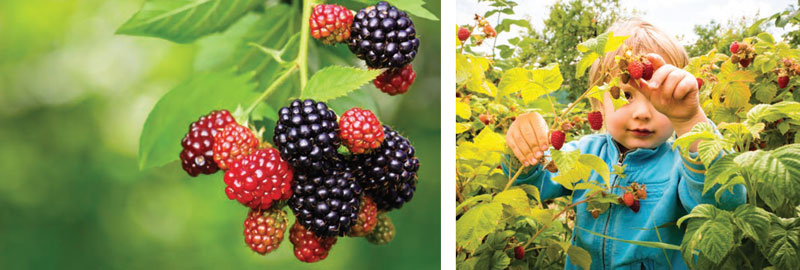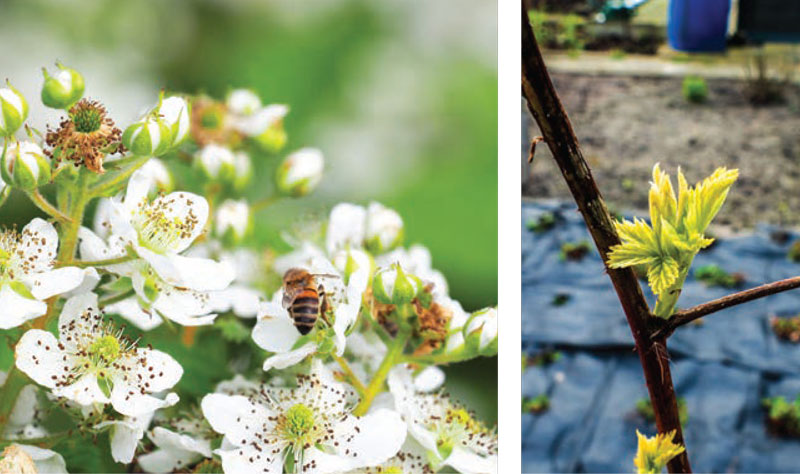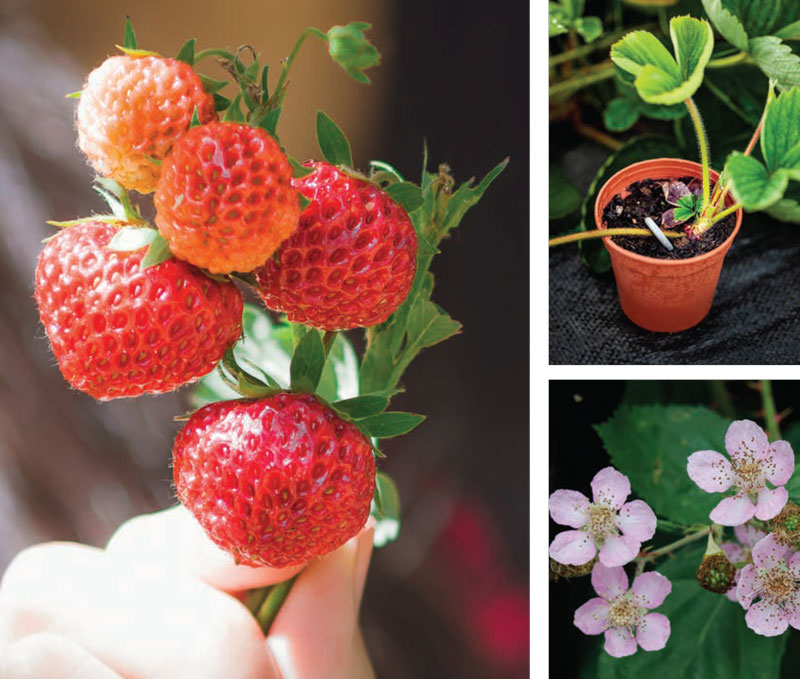Home-Grown Berries | The Best Part of Summer
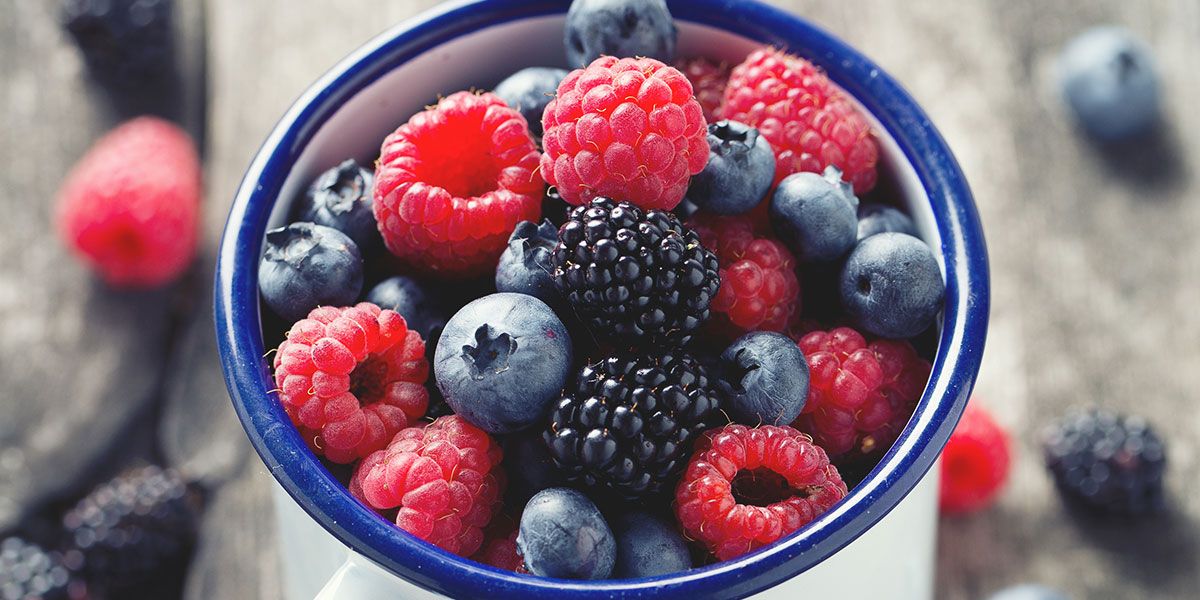
Nothing says summer like a fresh berry, and there is no better berry than one that is freshly picked from the garden. Thankfully, a backyard berry patch is a highly attainable goal for any gardener, for berries can easily be worked into your existing landscape. Strawberries can be a border, while berry bushes like blueberries, raspberries and blackberries can be hedge-defining areas in the garden. Known as “small fruits” for the size of the fruit these perennials produce, these plants require less space than fruit trees while also maturing faster, allowing the gardener to reap the rewards of their labor within a year or two of planting.
For the most part, small fruits grow just fine in sunny, well-drained but average soil. Particular plants will need some soil amendments, but overall, these plants are fairly low maintenance once established.
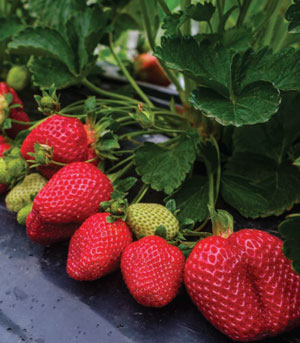 Strawberries
Strawberries
The first small fruit to ripen in the spring are strawberries. A plant that can be used as a ground cover and a border, strawberries also do well in container gardens. There are both spring (June) bearing and everbearing strawberry plants, although the recommended varieties for our area are primarily June bearing. June-bearing plants are short-day plants, forming blooms when there is less than 12 hours of sunlight a day. Recommended June-bearing cultivars include Sweet Charlie, Chandler, Flavorfest, Camino Real and Camarosa, while San Andreas and Albion are some everbearing varieties that do well in our region.
Strawberries grow best in a sandy, loam soil, but they will grow anywhere in well-drained soil that has been well supplied with organic matter. They’d prefer to not be near members of the nightshade family like eggplants and tomatoes, and they generally aren’t fond of being planted in southern-facing slopes, as too much sun can stymie the berry harvest. Strawberries need to be weeded regularly, as they don’t like being crowded. Plant strawberry rows 3 feet wide, with plants 1 to 3 feet apart. Strawberry plants produce both berries and runners—baby strawberry plants connected via a long stem—during their productive season; pinch the runners off to ensure better berry production. Strawberries should be planted in the early spring with the crown of the plant level with the soil surface. Pinching off blossoms the first year of planting helps ensure a better crop the next year. While the “mother” plants last only a few years, careful managing of mother plants with the “daughter” plants produced via runners ensures a healthy strawberry patch for years to come.
When planting strawberries in container gardens, the pyramid shape is one frequently used. It is an excellent method of maximizing limited space while ensuring a bountiful harvest. Whether you go with a clay strawberry pot or build a bed in your garden, containers are an efficient method of growing strawberries without needing a lot of space.
BLACKBERRY VARIETIES THAT DO WELL LOCALLY
early-bearing
Kiowa: thorny, produces the biggest berries Natchez: thornless, produces large, sweet fruit
mid-to-late-season bearing
Navaho: thornless, medium-sized berry
late-bearing
Chester: thornless, yields medium-sized fruit
primocane/everbearing
Prime-Ark 45: thorny large berries Prime-Ark Freedom: thornless, large fruits
RASPBERRY VARIETIES THAT DO WELL LOCALLY
floricane/summer bearing
Killarney: red, high-yielding
Latham: red, medium-yielding
Nova: red, midseason, slightly acidic tasting fruit
New Logan: black, heavy producer, drought-resistant
Jewel: black, high-yielding
Cumberland: black Royalty: purple, high-producing, thorny
Brandywine: purple, large, late-ripening
primocane/everbearing
Caroline: red
Heritage: red, can be susceptible to late leaf rust
Himbo Top: large fruit
Joan J: spine-free red
Caneberries
Caneberries, also known as brambles, are a relatively easy small fruit to grow in the home garden. Caneberries include raspberries and blackberries, named because of how they grow; their roots and crowns are perennial, shooting up canes that produce fruit. These canes only last two years and come in two fruiting types: primocane and floricane, otherwise known as everbearing and summer bearing, respectively. Primocane will bear fruit in the fall of the first year of their cane growth, then again the following June, although the fall harvest is more plentiful. These particular plants can be mowed down to the ground after the fall harvest and will pop back up next spring. Floricanes produce fruit only in their second year of growth.
Brambles do better when trellised; there are some relatively simple ways to do this, including a method involving wire strung between posts. Posts can be as far apart as 30 feet, with wires strung between them about 18 inches apart at heights starting at 3 feet above ground. Caneberries can be planted in the fall or early spring, in rows 8 feet apart or more, with 3 feet between plants, working the soil as you would the vegetable garden (well-drained soil rich in organic matter).
Caneberries need regular pruning at several points in the season, in what is called dominant and summer pruning. Dominant pruning—which removes all the dead, weak and damaged canes and selecting the canes that remain for fruiting in the coming season—should take place in spring, after the threat of severe cold has passed but before the buds begin to swell. Summer pruning—removing the top few inches of new shoots—takes place when the plants begin to reach particular heights (5 feet for blackberries, 3 to 4 feet for raspberries).
Blackberries offer thornless varieties while raspberries come in a range of colors—red, black, purple and yellow—that differ in flavor as well as production levels.
While it may be tempting to interplant several colors of raspberry varieties in one area, it’s important to note that different colors need to be planted several hundred feet away from each other to ensure each variety is properly pollinated and to avoid spreading disease. Additionally, black raspberries ripen before any other varieties and are the least cold hardy of all the raspberries. Yellow raspberries are the most delicate and not as widely grown, but are typically primocane berries and can be cut down to the ground each winter like the red varieties.
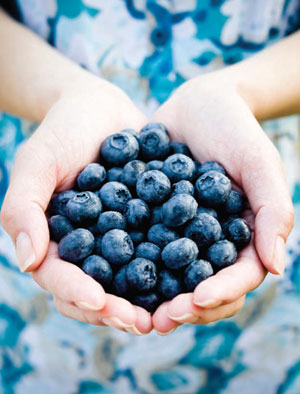 Blueberries
Blueberries
erhaps the easiest of all the small fruits to grow in your yard are blueberries. Not only are blueberries an edible landscaping feature, they offer spectacular fall color. They grow best in areas where azaleas, mountain laurel or rhododendrons grow, preferring more acidic soil. Similar to brambles, they require a good deal of water to help establish them their first year. Beyond that, blueberries are shallow rooted and like a steady amount of moisture, but they don’t tolerate saturated soils, so they must have adequate drainage. They prefer sunny, gentle slopes with a soil pH level of at least 4.5 to 5.5. Blueberries don’t like to be fertilized when being planted, so it is best to amend your soil a few weeks before planting. Once established, they will need some light pruning to remove dead and broken branches between the autumn leaf drop and spring growth.
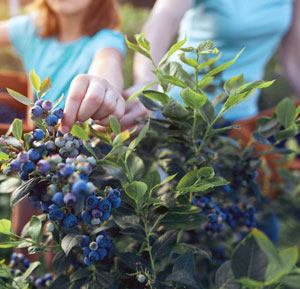 There are three types of blueberries that do well here in Virginia: rabbiteye, Southern highbush and Northern highbush. Rabbiteye and Southern highbush-type blueberries are best-suited for climates with hotter summers, with lower winter cool temperature requirements. Two or more varieties that bloom at the same time should be planted to provide adequate cross-pollination, ensuring a good crop of fruit, while also allowing one to extend the harvest.
There are three types of blueberries that do well here in Virginia: rabbiteye, Southern highbush and Northern highbush. Rabbiteye and Southern highbush-type blueberries are best-suited for climates with hotter summers, with lower winter cool temperature requirements. Two or more varieties that bloom at the same time should be planted to provide adequate cross-pollination, ensuring a good crop of fruit, while also allowing one to extend the harvest.
Among the rabbiteye varieties, there are the early-season types: Alapaha, Climax, Titan and Vernon; the mid-season varieties: Brightwell, Powderblue and Tifblue; and the late-season varieties of Centurion and Ochlokonee. Planting a variety of early, mid- and late-season rabbiteye blueberry bushes will allow you to harvest berries well into July and even August.
Southern highbush varieties are the most susceptible to late frosts, as they bloom early in the season, but they are also the variety most recommended for Central and Southern Virginia. Early season Southern highbush varieties are Suziblue, Palmetto and O’Neal while Camellia, Jubilee and Magnolia are the recommended midseason Southern highbush varieties for our area. Southern highbush varieties are also very popular with birds and deer, but the plants are easily netted to save your crop from passing wildlife. Birdnetting is a well-known approach, but bridal tulle is an excellent alternative to use as well. It still allows light to get to the plants, but because the construction of the fabric is finer, birds are not as likely to get tangled in it, which also makes it easier to use, as bird netting is easily tangled by humans as well.
Northern highbush blueberries are self-fertile, although larger and earlier ripening berries can result if several varieties are planted for cross-pollination. They do better in the mountainous and more northern regions of Virginia. Duke, Earliblue, Patriot and Spartan are good early season Northern highbush varieties while Bluecrop, Blueray and Legacy are hearty midseason varieties. Elliot and Jersey are good late-season Northern highbush blueberry bushes. Before choosing which small fruits you’d like to add to your edible landscaping, it is always advisable to do some research on the different varieties available, for just as there are a range of harvest times, there is a range of individual sizes and flavor profiles. Purchasing your berries from a local nursery can help ensure you are planting something that will do well in your garden for bountiful harvests in years to come. With a little planning, you can be assured that freshly harvested home-grown berries are just a few steps into the garden away. ✦
berry bushes, blackberries, blueberries, Caneberries, home-grown berries, June-bearing plants, raspberries, small fruits, Strawberries
